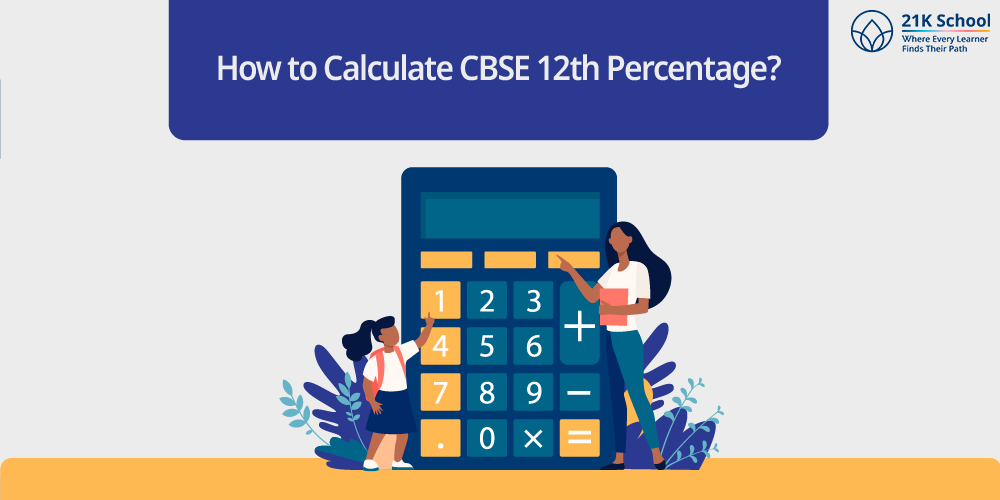
Are you struggling with your CBSE 12th percentage and don’t know how to calculate it?
Calculation of CBSE 12th percentage is easy and straightforward, students can easily calculate their percentage by their obtained marks and grade points.
CBSE 12th results show the grade achieved by students in their subjects. The CBSE grade system follows a grade between A to E, where A means Outstanding performance on the other hand E means failure.
CBSE Class 12 percentage is calculated based on the best 5 subjects, excluding additional subjects
To calculate the CBSE 12th percentage we need to divide total marks obtained/ total marks×100.
Lets know more about it in detail.
Table of Contents
How to Calculate CBSE 12th Percentage – 4 Steps
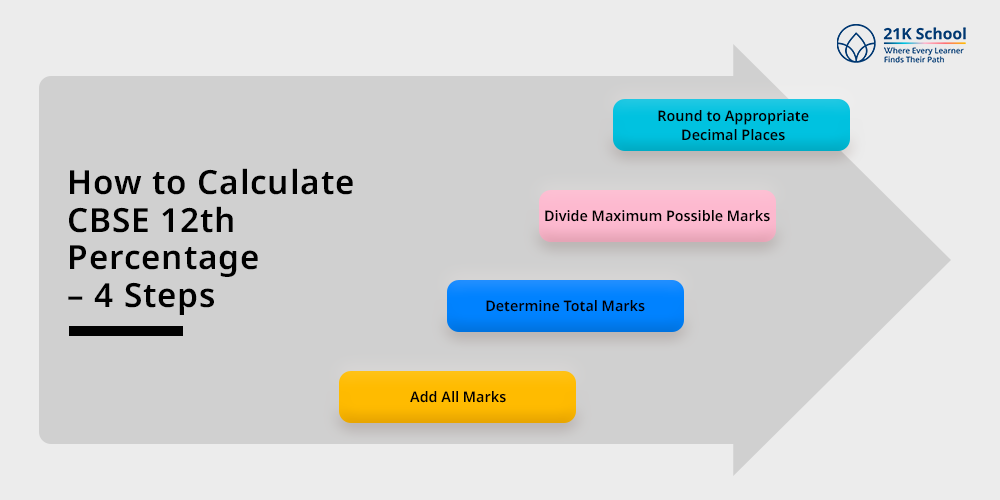
Candidates can easily follow their CBSE 12th percentage by adding all the marks obtained in each subject. After that, they can easily count their numbers based on the maximum marks achieved on their exams.
Explore how to get good marks in exam?
Students can easily calculate their percentage by using various percentage calculators. Here are the detailed steps through which you can calculate your CBSE 12th percentage.
1. Add All Marks

In the first step, students have to add all the obtained marks for every subject which also includes both theory and practical subjects. For example, if English subjects are of 100 marks that means 80 marks is for theories and 20 marks is for practical.
Let’s assume, you have five subjects in class 12 and the marks distribution is like that:
| Subject | Theory Marks | Practical Marks | Total Marks |
| English | 72 | – | 72 |
| Mathematics | 80 | – | 80 |
| Physics | 67 | 18 | 85 |
| Chemistry | 75 | 20 | 95 |
| Biology | 69 | 19 | 88 |
So you need to add all the subjects obtained marks.
72 (English) + 80 (Mathematics) + 85 (Physics) + 95 (Chemistry) + 88 (Biology) = 420 marks
2. Determine Total Marks

Now, candidates need to determine their total marks by multiplying the number of subjects by 100. For example, if you have five subjects, then you need to multiply it such as 5×100= 500, so 500 is your total marks.
3. Divide Maximum Possible Marks
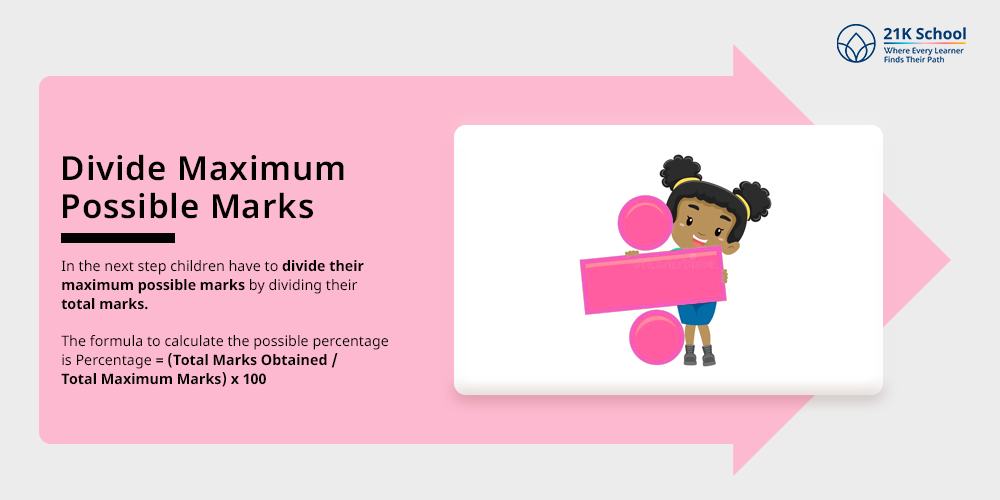
In the next step children have to divide their maximum possible marks by dividing their total marks. The formula to calculate the possible percentage is Percentage = (Total Marks Obtained / Total Maximum Marks) x 100
For example:
If you have obtained a marks of 450 out of 500 then is how you can apply the formula
Percentage = (450/ 500) x 100 = 84%
4. Round to Appropriate Decimal Places
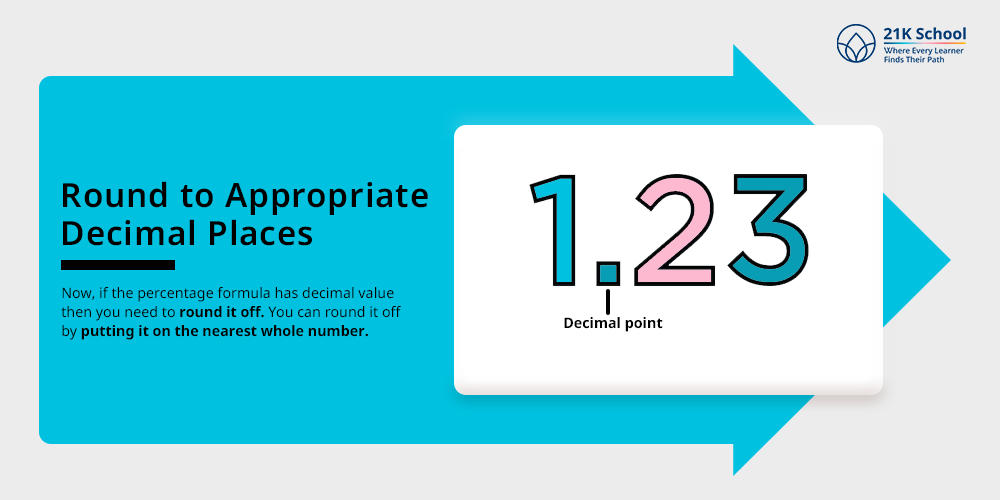
Now, if the percentage formula has decimal value then you need to round it off. You can round it off by putting it on the nearest whole number. For example, If you have a score of 84.6%, you can round it up to 85% for simplification.
Examples- How to Calculate CBSE 12th Percentage
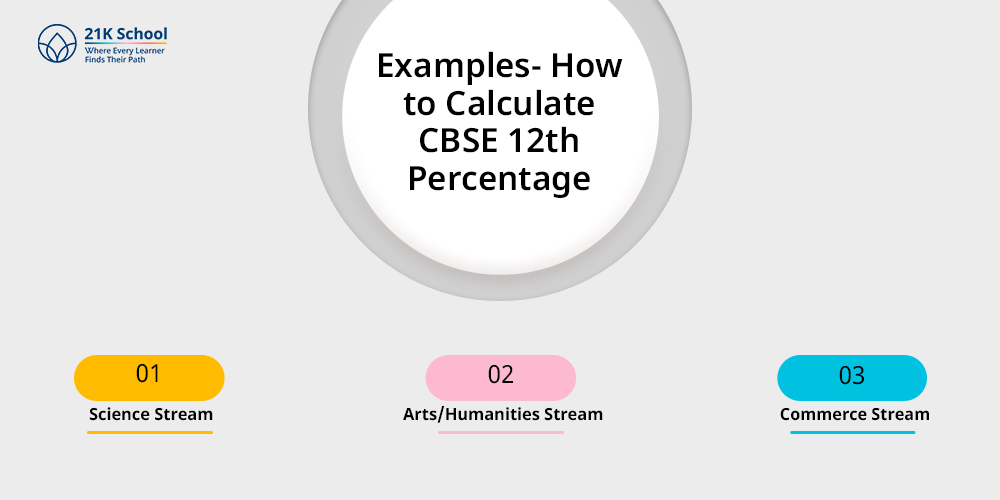
CBSE 12th percentage for all streams such as Science, Arts, and Commerce, follows the same calculation method, in which students have to apply the same formula.
The percentage formula for every stream is the same and candidates need to divide the obtained marks with the total marks multiplication with 100. Here is a detailed breakdown of CBSE percentage for every stream.
Science Stream

Science stream contains both practical and theoretical papers. The subjects of Science stream include Physics, Chemistry, and Biology (PCB). However, some students also opt for Physics, Chemistry and Mathematics (PCM).
- Theory: 80 marks per subject
- Practical/Internal Assessment: 20 marks per subject
- Total for One Subject: 100 marks
Arts/Humanities Stream

Arts stream contains a wide range of subjects mainly History, Civil, and Economics along with other languages or chosen subjects.
- Theory: 80 marks per subject
- Practical/Internal Assessment: 20 marks per subject
- Total for One Subject: 100 marks
Commerce Stream

Commerce mainly deals with Business and Entrepreneurship. This stream includes subjects such as Business Management, Accountancy, Financial Studies and so on.
- Theory: 80 marks per subject
- Practical/Internal Assessment: 20 marks per subject
- Total for One Subject: 100 marks
What is the CBSE 12th Grading System?

CBSE grading system contains 5 grade scale with grade of A to E. Where A stands for outstanding performance and E stands for fail or poor performance. The 9-point scale is used to assess students’ performance to understand their obtained marks.
CBSE abolished the CCE pattern and grading system display in mark sheets since 2017-18 for Class 10, and now shows results in percentage form.
CBSE assessments are evaluated based on the internal assessment and external assessment. Internal assessment includes tests, assessments, attendance and so on.
On the other hand, external assessment includes project works, field works, practical and viva voce. Here is the detailed grading system for CBSE 12th class.
| Range | Grades | Grade Point | Proportion of students |
| 91-100 | A1 | 10.0 | Top 1/8th of the passed candidates |
| 81-90 | A2 | 9.0 | Top 1/8th of the passed candidates |
| 71-80 | B1 | 8.0 | Top 1/8th of the passed candidates |
| 61-70 | B2 | 7.0 | Top 1/8th of the passed candidates |
| 51-60 | C1 | 6.0 | Top 1/8th of the passed candidates |
| 41-50 | C2 | 5.0 | Top 1/8th of the passed candidates |
| 33-40 | D | 4.0 | Top 1/8th of the passed candidates |
| 21-32 | E1 | C (Fail) | Top 1/8th of the passed candidates |
| 0-20 | E2 | C (Fail) | Failed candidates |
Calculating CBSE 12th Percentage- Common Issues and Solutions
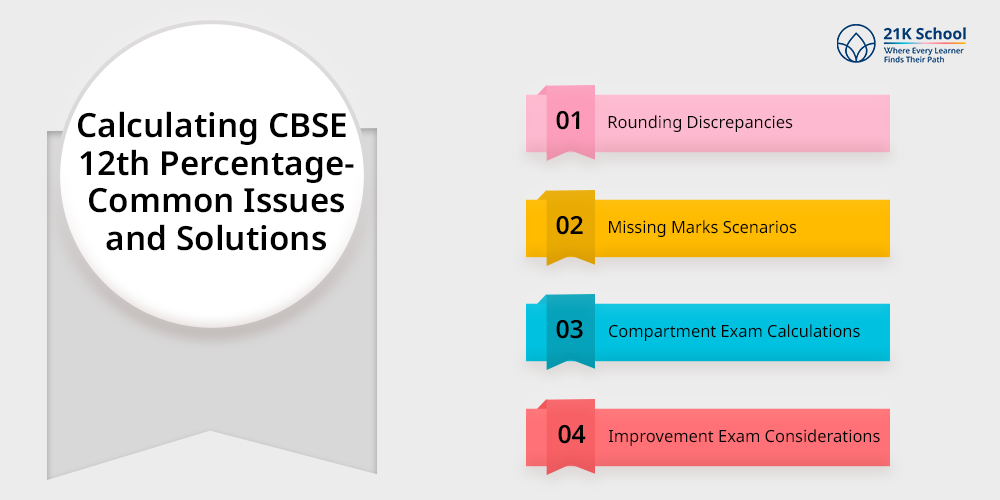
While calculating the CBSE 12th percentage, children find some issues which make them confused. These problems cause children to calculate the marks in a wrong way, however, this problem can be avoided through effective techniques.
1. Rounding Discrepancies
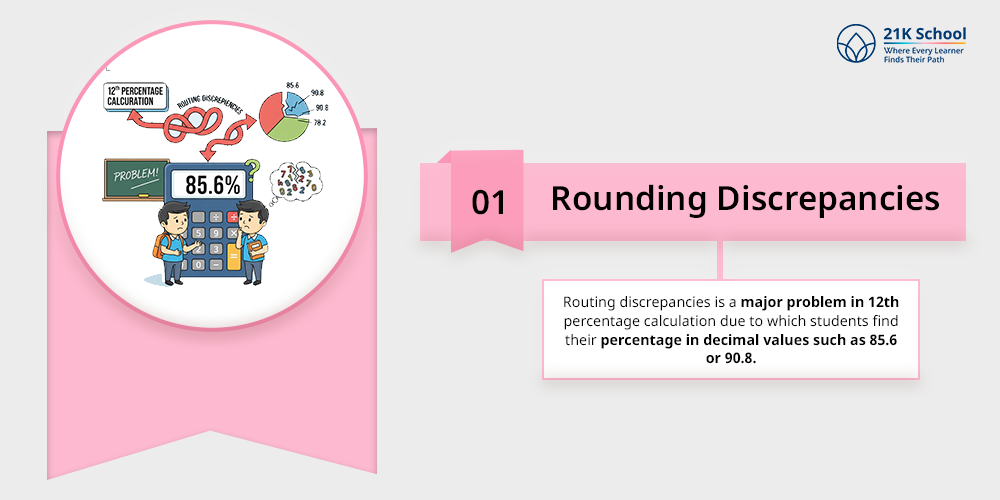
Routing discrepancies is a major problem in 12th percentage calculation due to which students find their percentage in decimal values such as 85.6 or 90.8. In such scenarios students find it difficult to understand their exact marks.
Solution for Rounding Discrepancies
This problem can be solved through roundoff technique which means children can round off by putting it on the nearest whole number. For example If you have a score of 75.6, you can round it up to 76% for simplification.
2. Missing Marks Scenarios
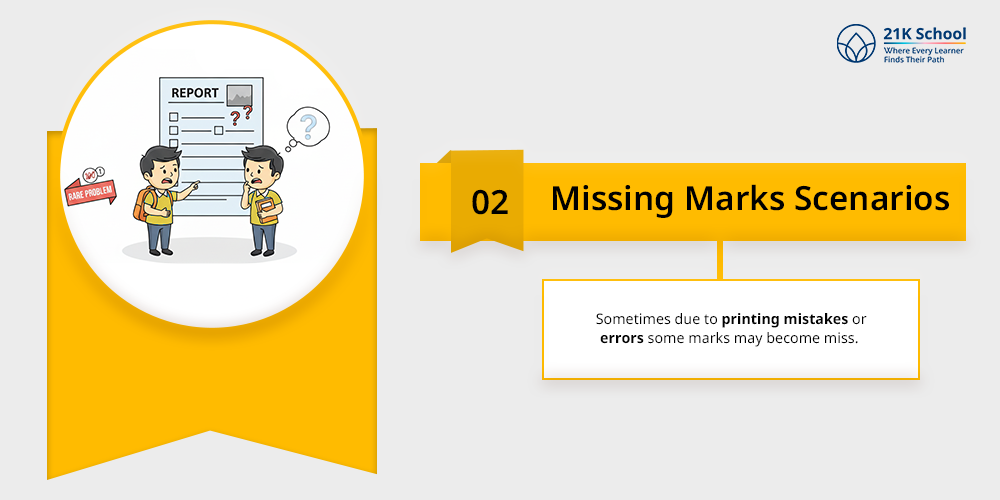
Missing marks scenario is a rare challenge finding during marks calculation. Sometimes due to printing mistakes or errors some marks may become miss. However, this problem occurs rarely.
Solution for Missing Scenarios
If any children find their marks missing they should immediately contact their exam boards and authorities for the rectification of the error. They can contact them over their e-mail address or should contact their school authorities.
3. Compartment Exam Calculations
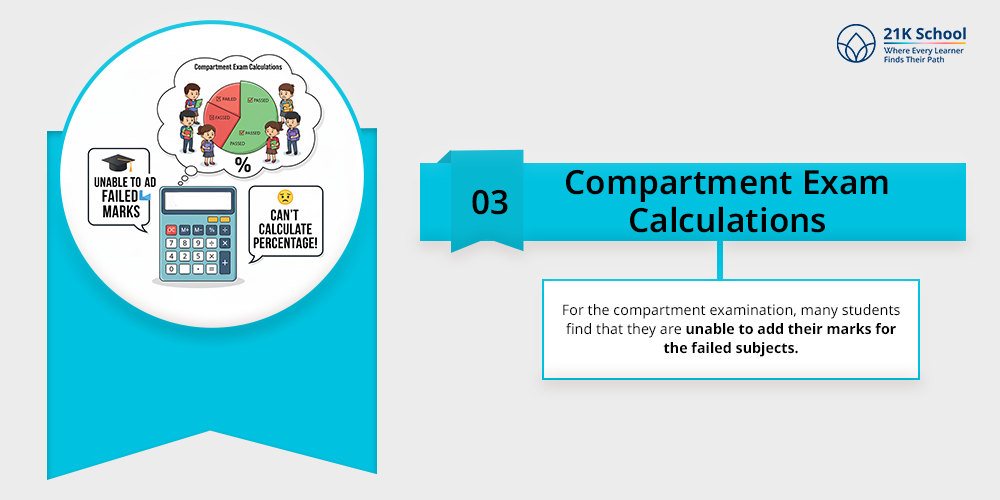
For the compartment examination, many students find that they are unable to add their marks for the failed subjects. For this reason they are unable to calculate their marks percentage.
Solution for Compartment Exam Calculations
Candidates can calculate their compartment examination based on the marks they have acquired in their re-examination. They need to use the same method of calculation for acquired subjects to get the final percentage.
4. Improvement Exam Considerations
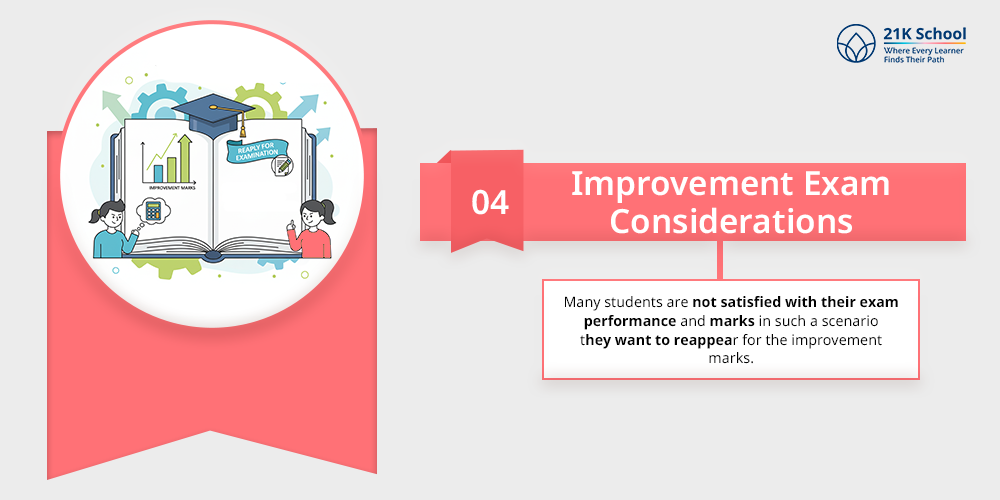
Many students are not satisfied with their exam performance and marks in such a scenario they want to reappear for the improvement marks. However, children who want to improve their marks need to reapply for the examination. In such scenarios they can calculate their exams based on the current marks.
Solution to Improve Exam Consideration
Students can solve this dilemma of improvement exams by reapplying for the examination. The marks calculation should be based on the current marks and not on the previous marks for best preparation and evaluation.
Read on to understand the benefits of CBSE board and how it creates a strong foundation.
Concluding words
So, it is easy to understand the detailed process to calculate the CBSE 12th percentage. All you need to do is calculate all the marks, determine the total marks, divide by maximum marks obtained, and then round off to the nearest decimal places.
You can get a quick help of the top examples covering the science stream, arts/humanities stream, or commerce stream. With a clear understanding of the CBSE 12th grading system and possible mistakes, you can ensure the right evaluation and percentage calculation.


